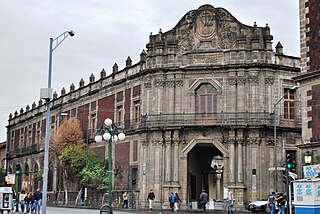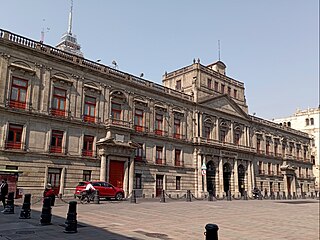
The National Autonomous University of Mexico, is a public research university in Mexico. It has several campuses in Mexico City, and many others in various locations across Mexico, as well as a presence in nine countries. It also has 34 research institutes, 26 museums, and 18 historic sites.
The Autonomous Technological Institute of Mexico, commonly known as ITAM, is a private university located in Mexico City. It is one of Mexico's most important institutions of higher learning; highly prestigious in the social sciences. It is also considered one of Mexico's think tanks and has the highest rank of admission to the Mexican Foreign Service.

Universidad de las Américas Puebla, commonly known as UDLAP, is a Mexican private university located in San Andrés Cholula, near Puebla. The university is known for its programs in Finance, Arts and Humanities, Social sciences, Science and Engineering, and Business and Economics. It is considered to be one of the most prestigious universities in Latin America, having been ranked the best private and single-campus university in Mexico by the newspaper El Universal, as well as being one of the only seven universities in Latin America accredited by the Southern Association of Colleges and Schools. The UDLAP has also been very successful in Mexican collegiate sports; their teams are the Aztecas.

Ciudad Universitaria is the main campus of the National Autonomous University of Mexico (UNAM), located in Coyoacán borough in the southern part of Mexico City. Designed by architects Mario Pani and Enrique del Moral, it encloses the Olympic Stadium, about 40 faculties and institutes, the Cultural Center, an ecological reserve, the Central Library, and a few museums. It was built during the 1950s on an ancient solidified lava bed in Coyoacán called "El Pedregal" to replace the scattered buildings in downtown Mexico City where classes were given. It was completed in 1954 at a cost of approximately $25 million. It was declared a World Heritage Site by UNESCO in 2007.

The Walter Cronkite School of Journalism and Mass Communication, is one of the 24 independent schools at Arizona State University and is named in honor of veteran broadcast journalist Walter Cronkite. The school, which is located at the downtown Phoenix campus, offers several undergraduate and graduate programs in journalism, and in fall 2011, launched its first doctoral program in journalism and mass communication.

The Autonomous University of Chihuahua is a Mexican public university based in the city of Chihuahua, Chihuahua, but with several campuses across the state. In December 8, 1954, the State Legislature, with Governor Oscar Soto Maynez, issued the decree 171, which founded the Autonomous University of Chihuahua (UACh). UACh was granted its autonomy in 1968, with the freedom to define its own curriculum and manage its own budget without interference from the government.

The First National Bank Building is a historic building in downtown Albuquerque, New Mexico, and the former headquarters of the First National Bank of Albuquerque. The nine-story building was completed in 1923 and was considered the city's first skyscraper with an overall height of 141 feet (43 m). It remained the tallest building in the city until 1954, when it was surpassed by the Simms Building.

Universidad Autónoma Chapingo is an agricultural college located in Texcoco, Mexico State in Mexico. The university is a federally funded public institution of higher education. It offers technical and full bachelor's degrees as well as having scientific and technological research programs. Many of these programs are related to agriculture, forestry and fishing.

The Autonomous University of Nayarit is a Mexican public university based in the city of Tepic, Nayarit, that offers secondary education in addition to undergraduate and graduate education. The university offers 15 preparatory schools located across the major regions of the state. The university offers 33 undergraduate degrees and 28 postgraduate degrees. Enrollment at the university level has been rising since 1996.
Zimmerman Field was a stadium located in Albuquerque, New Mexico. It opened in 1938 and hosted the University of New Mexico Lobos football team until they moved to University Stadium in 1960. The stadium continued in use for intramural sports until 1969, when it was demolished to make way for new academic facilities.

Colegio de San Ildefonso, currently is a museum and cultural center in Mexico City, considered to be the birthplace of the Mexican muralism movement. San Ildefonso began as a prestigious Jesuit boarding school, and after the Reform War it gained educational prestige again as National Preparatory School. This school and the building closed completely in 1978, then reopened as a museum and cultural center in 1992. The museum has permanent and temporary art and archeological exhibitions in addition to the many murals painted on its walls by José Clemente Orozco, Fernando Leal, Diego Rivera, and others. The complex is located between San Ildefonso Street and Justo Sierra Street in the historic center of Mexico City.

The Palace of the Inquisition stands on the corner of República de Brasil and República de Venezuela streets in Mexico City, Mexico. As neither side of the building faces Santo Domingo Plaza, the entrance is placed at a canted corner to face the plaza. Its long association with the Inquisition, which ended during the Mexican War of Independence, made it difficult to convert to other purposes. However, it eventually became the School of Medicine for the reconstructed National University. When UNAM moved to the Ciudad Universitaria in the 1950s, it retained ownership of this building, eventually converting the structure in what is today the Museum of Mexican Medicine.

The Antigua Escuela de Jurisprudencia building is located on the corner of Republica de Argentina and San Ildefonso Streets in the historic center of Mexico City. The building originally was convent for Dominican nuns called Santa Catalina de Siena.After the Reform Laws the government took possession of the building and worked to turn it into a military barracks, transforming and partially demolishing it. In the meantime, the National University of Mexico, the forerunner of UNAM, had been closed in 1833, and the Jurisprudence School was recreated at the College of San Ildefonso. In 1868, the National Preparatory High School was founded in the same building so the Jurisprudence School moved to the ex Convent of La Encarnación,(now SEP) and finally to the ex Convent of Santa Catalina de Siena. In 1908, Diaz inaugurated this building as the Escuela Nacional de Jurispudencia.

José Natividad Macías Castorena studied at the Seminary of León and the National Preparatory School. He also studied at the National School of Jurisprudence, where he earned his law degree in 1894. A teacher at the School of Jurisprudence in Guanajuato, he moved to Mexico City in the early 20th century to practice law at the invitation of President Porfirio Díaz after defeating him in a civil case while defending Don Manuel Urquiza, a landowner from Querétaro.
Rodulfo Brito Foucher (1899–1970) was a Mexican lawyer and academic who was rector of the National Autonomous University of Mexico from 1942 to 1944. He was the father of journalist and feminist activist Esperanza Brito de Martí.
Luis Chico Goerne (1892–1960) was a Mexican lawyer, academic, and rector. He was an expert in penal law who wrote and lectured in the fields of law and sociology and made significant contributions to Mexico's penal codes of 1929 and 1931.
Luis Pedro Alejandro Recasens Siches was a Spanish politician and a legal philosopher.

The Faculty of Law of the University of Oslo is Norway's oldest law faculty, established in 1811 as one of the four original faculties of The Royal Frederick University. Alongside the law faculties in Copenhagen, Lund and Uppsala, it is one of Scandinavia's leading institutions of legal education and research. The faculty is the highest-ranked institution of legal education in Norway and is responsible for the professional law degree, one of the most competitive programmes at any Norwegian university. Those admitted to the law programme at the University of Oslo tend to have an average high school grade that is higher than the highest grade, and are usually the best in their class at high school level.

Edgardo Buscaglia is a scholar and practitioner within the field of law and economics. Buscaglia is also an international philanthropist and civil society leader engaged in supporting non-governmental organizations in their combat and prevention of organized crime, including his support for combatting wildlife trafficking at the Wildlife Justice Commission or his philanthropic and technical support for preventing human trafficking in Mexico and Central America as Director of the International Law and Economic Development Center.

The Palace of Mining, also Palace of Mines, is a building in Mexico City, Mexico, considered to be a fine example of Neoclassical architecture in the Americas. It was designed and built between 1797 and 1813 by Valencian Spanish sculptor and architect Manuel Tolsá. It was built to house the Royal School of Mines and Mining of the Royal Court at the request of its director, Fausto Elhuyar, a scientifically-trained mineralogist.
















